20 +
Years Of Experiences

Taktsang Palphug Monastery, Punakha Dzong, Rinpung Dzong, Chele La Pass, Buddha Dordenma Statue, Dochula Pass, Tashichho Dzong, Phobjikha Valley, National Museum, Jigme Dorji National Park, Tashichho Dzongand,Simtokha Dzong, Tango Buddhist Institute and many more.
Surrounded by alluring natural beauty and charming age old Bhutanese architecture, the places to visit in Bhutan will surely impress you. Dotted with monasteries, romantic hotspots, nature reserves, and lush green valleys, Bhutan has got something or the other for all kinds of tourists. If you are a nature lover, then you can marvel at the nature reserves and scenic landscapes.
While the most sought after Bhutan tourist places, Paro Valley which is dotted with age old museums and magnanimous Rinpung Dzong fortress, the city of Thimpu offers monastery and nature tours. If you are an adventure enthusiast, then you can indulge in some of the nerve wracking activities like thrilling whitewater Rafting in the clear waters of Khamsum Yulley, steep rock Climbing in The Nose, Thimphu, kayaking in the Wang Chhu, Puna Tsang Chhu and much more.
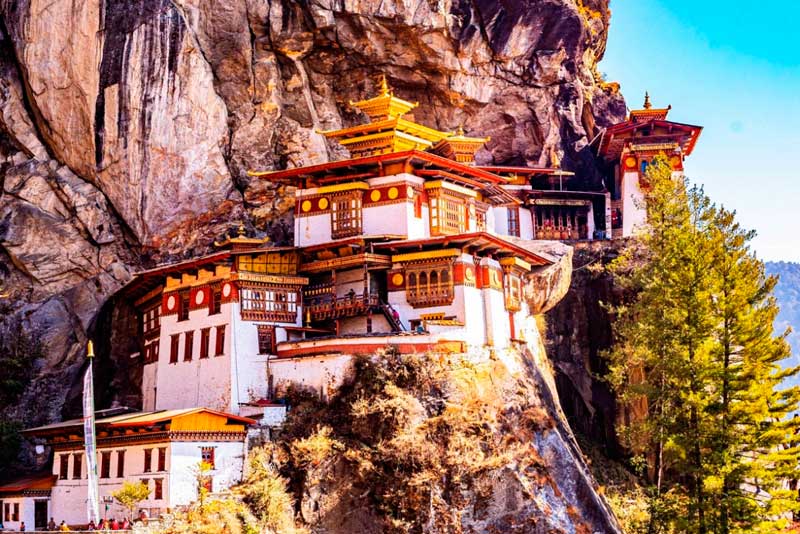
Paro Taktsang, also known as the Tiger's Nest, is a prominent Buddhist monastery and temple complex located in the Paro Valley, Bhutan. It is perched on the edge of a steep cliff at an altitude of 3,120 meters (10,240 feet) above sea level.The Taktsang Monastery is a sacred pilgrimage site and one of Bhutan's most iconic landmarks. It is believed to have been first built in 1692, around the cave where Guru Rinpoche (Padmasambhava), the founder of Tibetan Buddhism, meditated in the 8th century.To reach Paro Taktsang, visitors must embark on a challenging hike that takes approximately 2-3 hours. The trail offers breathtaking views of the surrounding mountains and valleys. Along the way, there are small teahouses where visitors can rest and enjoy refreshments.
The monastery complex consists of several temples, prayer rooms, and meditation caves. The main temple houses a stunning statue of Guru Rinpoche, along with various religious artifacts and paintings. Visitors can also explore the nearby caves where Guru Rinpoche is said to have meditated.Paro Taktsang is not only a spiritual and cultural site but also a symbol of Bhutan's rich history and natural beauty. It attracts thousands of visitors each year who come to witness its awe-inspiring architecture, religious significance, and panoramic views of the Paro Valley.Visitors are required to dress modestly and respectfully when visiting Paro Taktsang. It is advisable to wear comfortable walking shoes and carry sufficient water and snacks for the hike. Photography is permitted in certain areas, but it is important to follow the guidelines and respect the sanctity of the monastery.
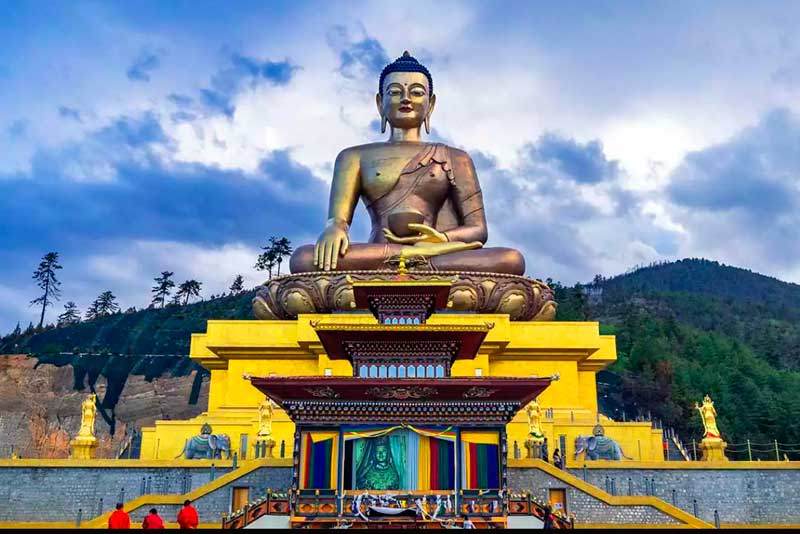
Buddha Dordenma is a magnificent and iconic statue of Lord Buddha located in Thimphu, the capital city of Bhutan. It stands at a height of 169 feet (51.5 meters), making it one of the tallest Buddha statues in the world. The statue is made of bronze and gilded in gold, radiating a majestic presence.The Buddha Dordenma statue is situated atop a hill, offering panoramic views of the surrounding mountains and the Thimphu valley. It was constructed to celebrate the 60th anniversary of the fourth king of Bhutan, Jigme Singye Wangchuck.The statue is a representation of the Buddha Amitabha, the Buddha of Infinite Light. It is believed that the presence of the Buddha Dordenma brings peace, happiness, and prosperity to Bhutan and its people.Inside the statue, there are several chapels and meditation halls adorned with intricate murals and religious artifacts. The main hall houses a large bronze statue of Shakyamuni Buddha, surrounded by smaller statues and religious paintings.Buddha Dordenma has become a popular tourist attraction and a significant pilgrimage site for Buddhists. Visitors can explore the beautifully landscaped gardens surrounding the statue, offering serene and peaceful surroundings.
The site also includes a meditation center where individuals can engage in contemplation and spiritual practices. It serves as a place of retreat and reflection, providing an opportunity for visitors to connect with their inner selves and find solace.Buddha Dordenma is not only a religious monument but also a symbol of Bhutan's deep-rooted Buddhist culture and values. It serves as a reminder of the country's commitment to promoting peace, harmony, and spiritual well-being.Visitors are advised to dress modestly and respectfully when visiting Buddha Dordenma. It is a place of reverence, and appropriate behavior is expected. Photography is allowed in most areas, but it is important to be mindful and respectful of the surroundings.
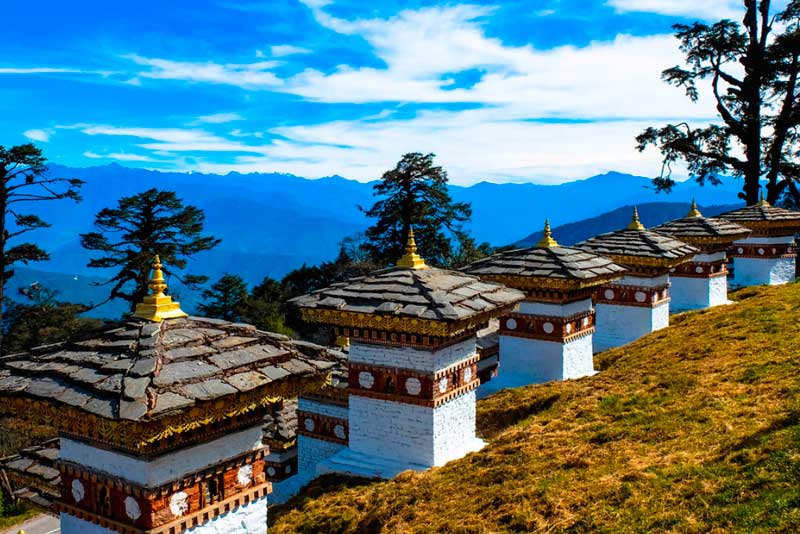
Dochula Pass is a scenic mountain pass located on the road from Thimphu to Punakha in Bhutan. Situated at an elevation of 3,100 meters (10,200 feet), it offers breathtaking panoramic views of the surrounding Himalayan mountain ranges.The pass is known for its 108 chortens (Buddhist stupas) that were built to honor Bhutanese soldiers who lost their lives in a conflict with Indian insurgents. These chortens, also known as Druk Wangyal Chortens, stand tall against the backdrop of snow-capped peaks, creating a picturesque and spiritual ambiance.Aside from the chortens, Dochula Pass is also famous for its prayer flags that flutter in the wind, adding vibrant colors to the landscape. The prayer flags are believed to carry prayers and blessings to the heavens, spreading positive energy and goodwill.On clear days, the pass offers mesmerizing views of the Bhutanese Himalayas, including prominent peaks like Mount Masanggang, Gangkar Puensum, and Table Mountain. The unobstructed vistas of the towering mountains, covered in snow or clothed in lush greenery, leave visitors awe-struck and provide ample opportunities for photography.
Dochula Pass is not only a scenic spot but also a popular pilgrimage site for Bhutanese locals. It holds deep religious significance, and many Bhutanese visit the pass to offer prayers and seek blessings. The tranquil and serene environment, coupled with the stunning natural beauty, creates a peaceful and spiritual atmosphere.Visitors can also enjoy refreshments at the Dochula Cafeteria, which offers a cozy setting and a chance to relax while taking in the magnificent views. It is an ideal spot to savor a cup of Bhutanese tea or coffee and indulge in some local snacks.Whether you are a nature enthusiast, a photography enthusiast, or someone seeking spiritual solace, a visit to Dochula Pass is a must when exploring Bhutan. It showcases the country's natural splendor, cultural heritage, and devotion to Buddhism, leaving a lasting impression on all who venture to this enchanting mountain pass.
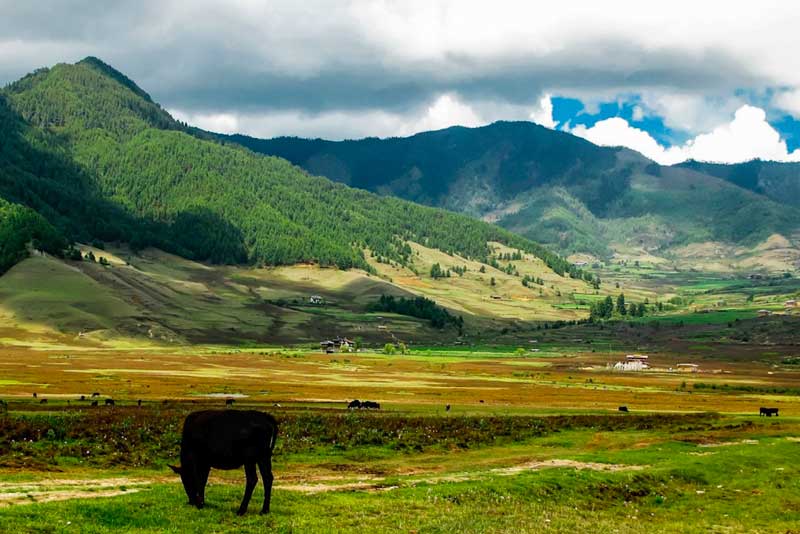
Phobjikha Valley, also known as Gangtey Valley, is a scenic and picturesque destination located in the Wangdue Phodrang district of Bhutan. Situated at an altitude of about 3,000 meters (9,800 feet) above sea level, the valley is renowned for its natural beauty, rich biodiversity, and cultural significance.The valley is famous for being the winter habitat of the endangered black-necked cranes that migrate from the Tibetan Plateau. These graceful birds arrive in the valley during the winter months, typically from late October to mid-February. Their arrival is celebrated with the annual Black-Necked Crane Festival, which showcases the unique Bhutanese culture and traditions associated with the cranes.Phobjikha Valley is also home to the Gangtey Monastery, a prominent Buddhist monastery that dates back to the 17th century. The monastery holds great religious and cultural significance and is an important center for Buddhist studies and practices. Visitors can explore the monastery, admire its architectural beauty, and witness the daily rituals and prayers conducted by the resident monks.The valley offers breathtaking landscapes with rolling hills, pristine forests, and open meadows. The picturesque surroundings provide ample opportunities for nature walks, hiking, and bird-watching. Visitors can take leisurely strolls along the designated trails, enjoying the fresh mountain air and spotting various flora and fauna.
The Phobjikha Valley is also known for its agricultural practices, particularly the cultivation of potatoes. The valley's fertile lands support the growth of this staple crop, and visitors can learn about traditional farming methods and interact with the friendly local farmers.For those seeking cultural immersion, the valley offers homestay experiences where visitors can stay with local families and learn about their way of life, customs, and traditions. It provides a unique opportunity to gain insights into the authentic Bhutanese lifestyle and foster cross-cultural exchanges.Overall, Phobjikha Valley captivates visitors with its serene ambiance, untouched natural beauty, and cultural richness. It is a destination that offers a glimpse into Bhutan's biodiversity, spirituality, and traditional way of life, making it a must-visit place for nature lovers, bird enthusiasts, and cultural enthusiasts alike.
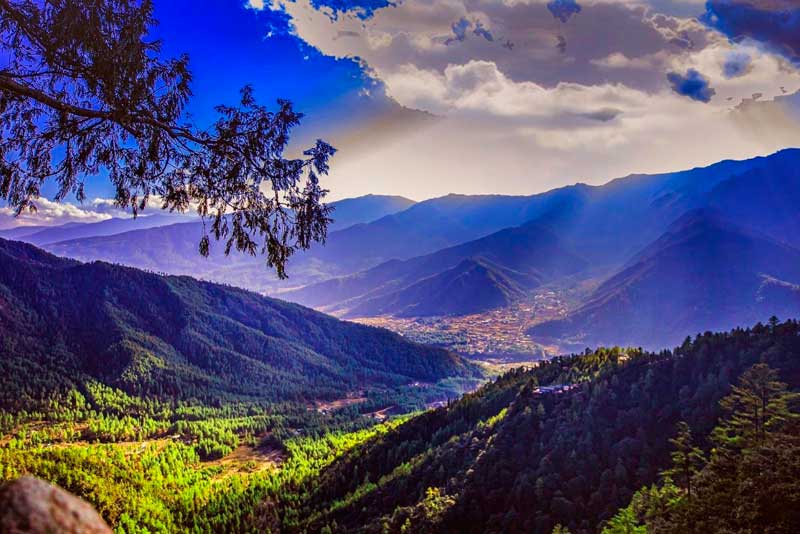
Haa Valley, located in the western part of Bhutan, is a hidden gem nestled amidst the pristine Himalayan mountains. It is one of the least-visited and unspoiled valleys in the country, offering a peaceful and off-the-beaten-path experience to visitors.The valley is known for its breathtaking landscapes, including rolling hills, lush green meadows, and dense pine forests. It is surrounded by towering peaks, including Mount Jomolhari and Mount Jitchu Drake, adding to its natural beauty. The picturesque beauty of Haa Valley makes it a paradise for nature lovers, photographers, and adventure seekers.The valley is dotted with traditional Bhutanese villages, where visitors can witness the authentic rural life of the locals. The villagers maintain their traditional lifestyle, living in traditional houses and practicing age-old customs and traditions. Exploring these villages provides a glimpse into the rich cultural heritage of Bhutan.
One of the major attractions in Haa Valley is the Haa Dzong, also known as Lhakhang Karpo (White Temple) and Lhakhang Nagpo (Black Temple). These two ancient temples stand at the foothills of the valley and hold significant religious and historical importance. They are adorned with intricate Bhutanese architectural designs and are a sight to behold.Haa Valley is also known for its annual summer festival, the Haa Summer Festival, which showcases the unique culture, traditions, and cuisine of the Haa region. The festival features traditional dances, music performances, sports competitions, and exhibitions of local arts and crafts. It is a vibrant celebration that provides an opportunity to immerse oneself in the local culture and interact with the friendly Haa community.Adventure enthusiasts can indulge in various outdoor activities in Haa Valley, including hiking, trekking, and mountain biking. The valley offers several scenic trails that lead to pristine lakes, high mountain passes, and panoramic viewpoints. It is a paradise for trekkers looking for off-the-beaten-path routes and breathtaking vistas.
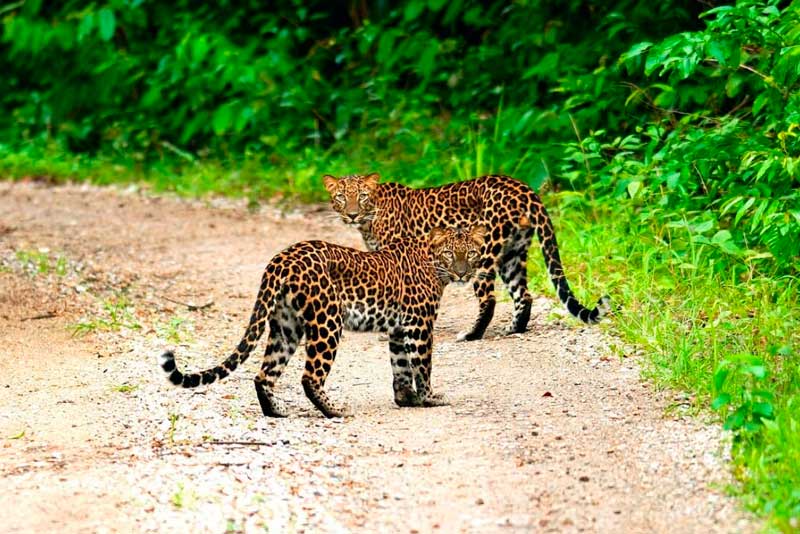
The Royal Manas National Park, located in the southern part of Bhutan, is a remarkable protected area renowned for its rich biodiversity and cultural significance. As one of the oldest national parks in Bhutan and a UNESCO World Heritage Site, it covers an expansive area of approximately 1,057 square kilometers. The park's diverse landscape encompasses subtropical and tropical ecosystems, featuring dense forests, grasslands, river valleys, and rugged mountainous terrain.The Royal Manas National Park is a sanctuary for numerous rare and endangered species, including the majestic Bengal tiger, Asian elephant, clouded leopard, Himalayan black bear, and greater one-horned rhinoceros. Its pristine wilderness is also a haven for bird enthusiasts, with a variety of bird species thriving within its boundaries.
Beyond its natural wonders, the park holds immense cultural significance. It is home to indigenous communities such as the Monpas, who have a deep spiritual connection with the land. Visitors to the park can witness the harmonious coexistence of nature and culture, immersing themselves in the local traditions and customs.Exploring The Royal Manas National Park offers a captivating journey into the heart of Bhutan's sacred Himalayas. From encountering incredible wildlife to experiencing the serenity of untouched landscapes, this national park is a sanctuary of natural and cultural heritage, inviting visitors to connect with the awe-inspiring beauty of the region.

Punakha Dzong, also known as the "Palace of Great Happiness," is a magnificent fortress located in the Punakha Valley of Bhutan. It stands at the confluence of the Pho Chhu and Mo Chhu rivers, symbolizing the union of male and female energies. Built in the 17th century, the dzong serves as both a religious and administrative center.The architecture of Punakha Dzong is awe-inspiring, characterized by towering whitewashed walls, golden spires, and intricate woodwork. Its strategic location on a hilltop provides panoramic views of the surrounding valley and mountains. Inside, visitors are greeted by ornate courtyards, intricate murals depicting Buddhist teachings, and sacred temples.One of the most significant events held at Punakha Dzong is the Punakha Tshechu, a vibrant festival celebrating Bhutanese culture and religion. During this festival, locals and tourists come together to witness masked dances, traditional music performances, and religious rituals, creating a festive atmosphere.
Besides its cultural significance, Punakha Dzong holds historical importance as the former capital of Bhutan. It has witnessed the coronation ceremonies of the kings of Bhutan and continues to serve as the winter residence for the clergy.Visiting Punakha Dzong allows travelers to immerse themselves in Bhutan's rich heritage and spiritual traditions. The grandeur of the architecture, the serenity of the surroundings, and the palpable sense of spirituality make it a must-visit destination for those seeking a deeper understanding of Bhutan's cultural and historical roots.
Years Of Experiences
Exotic Destinations
Tour Packages
Guest Satisfaction




copyrights © Sacred Himalaya Travel. all rights reserved. designed byTechno Imagine